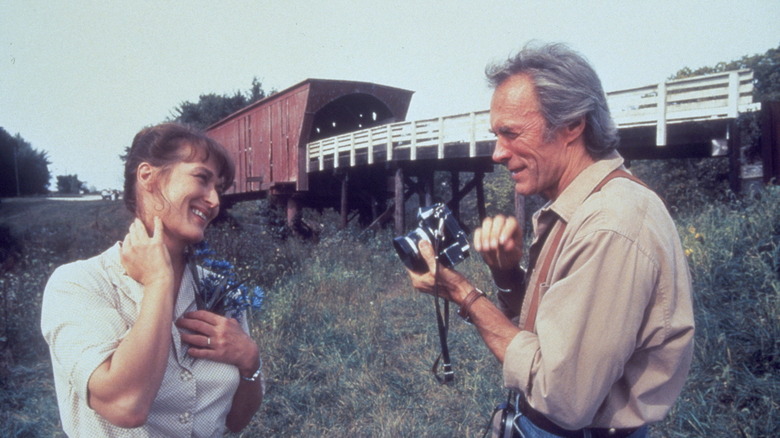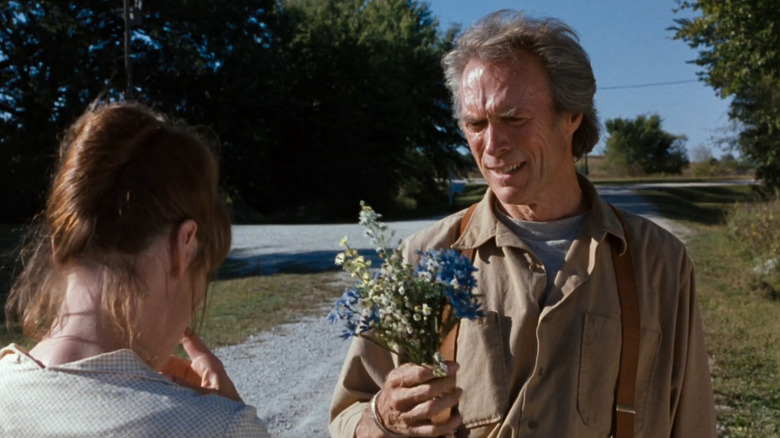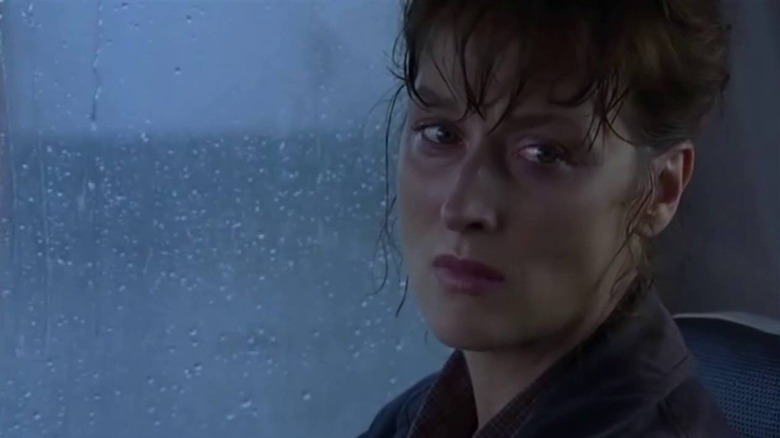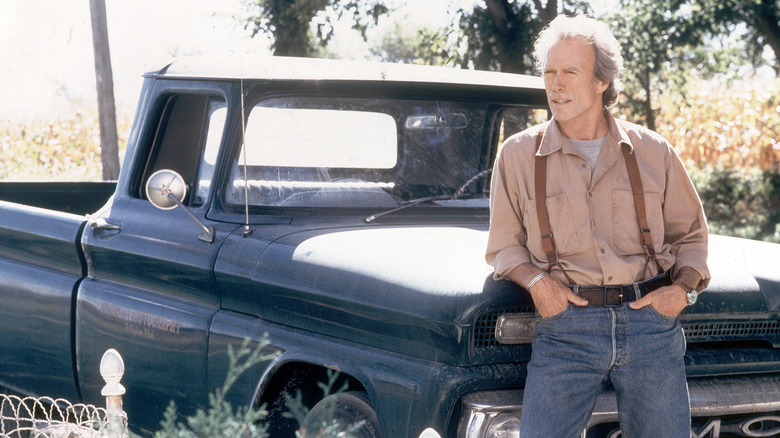Clint Eastwood Borrowed From His Western Heroes While Directing The Bridges Of Madison County
Across the wide open spaces of Iowa, a stranger rides into view of an isolated farmstead. The stranger is played by Clint Eastwood, but, unlike his Man With No Name or High Plains Drifter, he rides a pickup truck and uses a camera instead of a six-shooter to capture his targets.
While the blurb of Robert James Waller's bestseller "The Bridges of Madison County" makes it sound more like a modern day version of "Brief Encounter" than a western, there are elements of the story's Robert Kincaid — a wandering, rootless photo journalist — that made Eastwood first choice for the part.
Amblin Entertainment snapped up the rights to Waller's novel before it even hit the shelves, with Steven Spielberg originally planning to direct Eastwood in the film adaptation. After Spielberg decided to take time out after "Schindler's List," the project went to Sydney Pollack and then Bruce Beresford before Eastwood got the chance to direct and star alongside the great Meryl Streep.
A three-hanky weepie was an interesting change of pace for Eastwood, who was still working through variations of his tough guy screen persona; just a few years earlier, he was on buddy cop duty with Charlie Sheen in "The Rookie." But Eastwood made an unexpectedly appealing romantic lead, and "Madison County" made sense in the context of his directorial career. After his Oscar-winning triumph "Unforgiven," both "A Perfect World" and "Madison County" brought elements of the western into the 20th century world. Eastwood even took his cue from two legendary western directors in his approach to the material.
So what happens in The Bridges of Madison County again?
In the modern day, we meet Michael and Carolyn Johnson (Victor Slezak and Annie Corley), two grown-up siblings who return to their childhood home in Iowa to settle the estate of their mother Francesca (Streep), who has recently passed away. Going through her will and personal papers, they are shocked to discover that she had a brief, life-changing affair back in the '60s, and requested for her ashes to be scattered at the same spot as her lover's rather than a traditional burial next to her late husband.
Michael is especially hurt by the idea, but Francesca left three journals in the hope of explaining the situation to them. Her writings take us back to the '60s and the day when Robert Kincaid (Eastwood) rides into her life. Her affable but unexciting husband is away at the state fair with the kids when Kincaid swings by the house asking for directions to the Roseman bridge. He's on an assignment to photograph the County's famous covered bridges, but many of the roads are unmarked. Instinctively trusting him not to be a serial killer, Francesca hops into the truck to show him the way.
They are instantly attracted to each other and embark on an intense four-day love affair, keeping their heads down to prevent causing a local scandal. Despite their feelings for one another, they both know it can't last. Kincaid is a wandering soul and Francesca's commitment to her husband and kids are too strong for her to leave behind, although her resolve is sorely tested in the film's heartbreaking conclusion.
Eastwood took inspiration from the great western directors
Speaking about his filmmaking style on "The Bridges of Madison County," Eastwood name checked two of the great western directors, John Ford and Howard Hawks. Eastwood said (via Los Angeles Times):
"What I tried to do with this movie is show a lot of real time between people, where in movies today, because of our MTV mentality or whatever, we cut to the action here and the chase–quick, get the dialogue out so we can get to some movement. And this is a lot of real time between people where they're just standing there talking."
For a Hollywood production with major stars, "The Bridges of Madison County" feels more like a European arthouse film in how much time it devotes to just two people interacting, with lengthy scenes of the two lovers observing, responding, and talking, with plenty of glances and meaningful silences between. Eastwood continued:
"As a director you have to be careful with a story like this not to try to be razzle-dazzle. I tried to be more in the Ford or Hawks tradition of allowing things to happen on the screen. Otherwise it can get like you're shooting a commercial or something, with the camera sliding all over the place."
There is hardly a razzle-dazzle moment in Eastwood's entire directorial career, but his adherence to the style of two old masters pays dividends in the film, which is one of the best-loved and rewarding of modern movie romances.
Does The Bridges of Madison County hold up?
Thanks to the patient, mature screenplay of Richard LaGravanese and Eastwood's typically old-school direction, "The Bridges of Madison County" has aged very well compared to some of its more standard happy-ever-after contemporaries like "Sleepless in Seattle" or "While You Were Sleeping." What I like about Eastwood is that he treats his audience like grown-ups and trusts them with a little patience while he unfolds the story in unhurried fashion. In a film like "Madison County," that approach really gives the characters room to breathe when so much depends on longing looks, furtive touches, and heartfelt pauses. The script is good, but this is a film you could watch on mute and still understand exactly how these characters are feeling towards each other.
LaGravanese pared back much of the gushy excesses of Waller's critically maligned (but extremely popular) novel and added the framing device of Francesca's kids finding out about the affair, which is a good choice because it adds an extra emotional dimension to the story. Without those modern day scenes, the film would basically be a two-hander for Streep and Eastwood, who are both superb.
As director, Eastwood has a utilitarian approach, regarding the camera as a simple tool to tell a story and capture performances. For him, it's like a screwdriver rather than a paintbrush and his no frills style benefits the film, really allowing us to focus on the characters and their relationship. Even the score is used sparingly, becoming more prominent as Eastwood allows a little more sentimentality to creep into the last act. By that stage, the bigger emotions feel earned, and it would take a very hard heart to remain unmoved by that heartbreaking finale.



